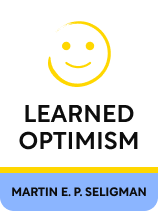

This article is an excerpt from the Shortform book guide to "Learned Optimism" by Martin E. P. Seligman. Shortform has the world's best summaries and analyses of books you should be reading.
Like this article? Sign up for a free trial here.
What is learned helplessness? How does negative self-talk fuel the problem? How can you overcome learned helplessness?
Psychologist Martin Seligman says you can unlearn helplessness and train your mind to be more naturally optimistic. In his book, Learned Optimism, Seligman explains two techniques for battling harmful self-talk to create a healthy mindset.
Read on to learn Seligman’s two techniques for overcoming learned helplessness.
Overcoming the Learned Helplessness Mindset
Seligman says that learned helplessness (or pessimism) and learned optimism come from our thought patterns: how we explain events to ourselves and how we view ourselves in relation to the world. Therefore, we can overcome learned helplessness and learn optimism by working on changing our thought patterns. (Seligman calls these thought patterns “explanatory styles.”)
We shape our thought patterns based on our time in school, our interactions with our parents, and our general life experiences. However, we’re not stuck with whatever way of thinking we learned as children. You can overcome learned helplessness by becoming aware of your thought patterns, applying consistent effort, and undergoing cognitive therapy. You can change the way you think.
| What Is Cognitive Therapy? Seligman proposes Cognitive Therapy (CT) as a way to change your thought patterns. CT is a type of treatment plan for mental disorders; it’s based on the idea that psychological problems are rooted, at least partially, in harmful and uncontrolled thought patterns. So—with the help of a therapist or psychologist—the patient examines his or her thoughts, feelings, and beliefs to look for faulty and unhelpful habits. After identifying those unhealthy ways of thinking, the patient and the therapist can work together to adjust them. Cognitive Behavioral Therapy (CBT) is based on the same principles as CT, but also helps patients to develop healthy new behaviors. Some studies have shown that Cognitive Behavioral Therapy (CBT) is more effective than medication at treating depression, though others say that a combination of both is the best treatment. Because it’s a more proactive approach, most psychologists prefer CBT to CT, so most of the information that’s readily available is specifically about CBT. |
Techniques to Dispute Harmful Self-Talk
Seligman offers a couple of techniques, drawn from cognitive therapy, to help you overcome learned helplessness by changing the way you explain negative events to yourself.
Overcoming Learned Helplessness: Technique #1
The first technique is to examine your belief. Start this process by asking yourself if what you believe is really true. What evidence is there for it and against it? After considering that evidence, does your belief seem rational? Also, ask what the implications of your belief are. In other words, if it were true, what would that mean for you? Conversely, what would it mean for you if you were wrong?
Once you’ve considered whether your belief is true or not, and what that means for you, think about if your belief is useful. Does it empower you, energize you, or help you prepare for the future? If not, is it worth holding on to this belief? On that note, think about some different beliefs you could replace it with. How else might you interpret the event in question? Is there an explanation that doesn’t depend on something being wrong with you?
(Shortform note: While useful for reframing your thoughts, Seligman’s process here doesn’t suggest any course of action you can take based on your beliefs. To that end, in The 4-Hour Workweek, entrepreneur and lifestyle guru Tim Ferriss suggests another useful question to ask yourself in stressful or worrisome situations: What will I do about it? In other words, if the belief that you’re worrying about actually turns out to be true, how would you handle it? Planning for the worst can help you stay calm and confident, as long as you don’t keep dwelling on the worst once your plan is in place.)
Overcoming Learned Helplessness: Technique #2
The second technique is to give pessimistic beliefs an external voice. Find a friend who’s willing to roleplay your negative beliefs. Have that person attack you the same way you attack yourself, and learn to defend yourself from that sort of aggression. You may find it easier to fight back against an external voice, and having to defend yourself out loud might help you to hear how fair and reasonable those defenses really sound.
(Shortform note: Another way of coming to terms with that negative voice in your head is to give it a silly name and a silly voice. In short, turn your inner critic into a character you can’t take seriously, and it will lose its power over you—for example, it’s hard to feel worried or upset when your inner critic sounds like Skeletor.)

———End of Preview———
Like what you just read? Read the rest of the world's best book summary and analysis of Martin E. P. Seligman's "Learned Optimism" at Shortform.
Here's what you'll find in our full Learned Optimism summary:
- How to break out of a pessimistic, powerless mindset
- How to develop a mindset of empowerment, optimism, and confidence
- How to balance your optimism with realism






